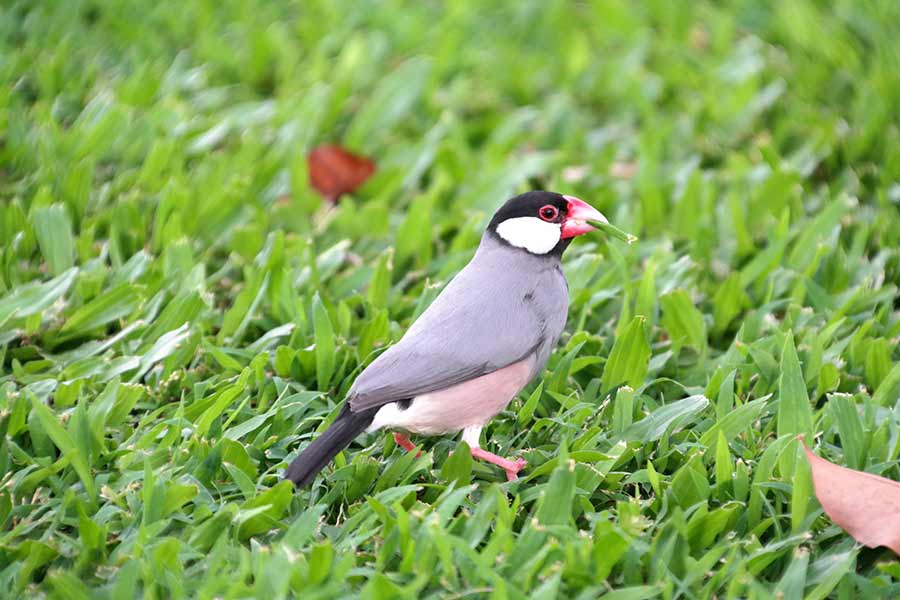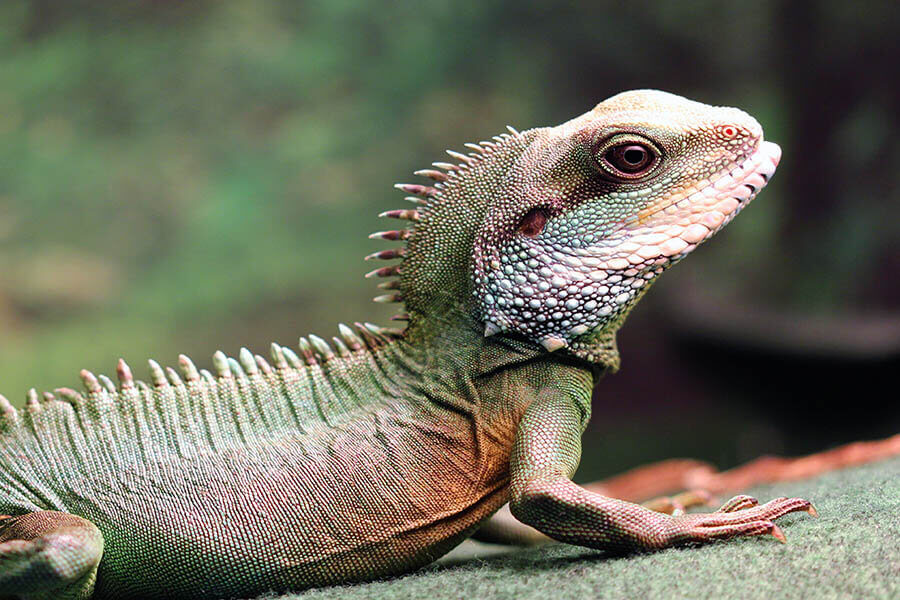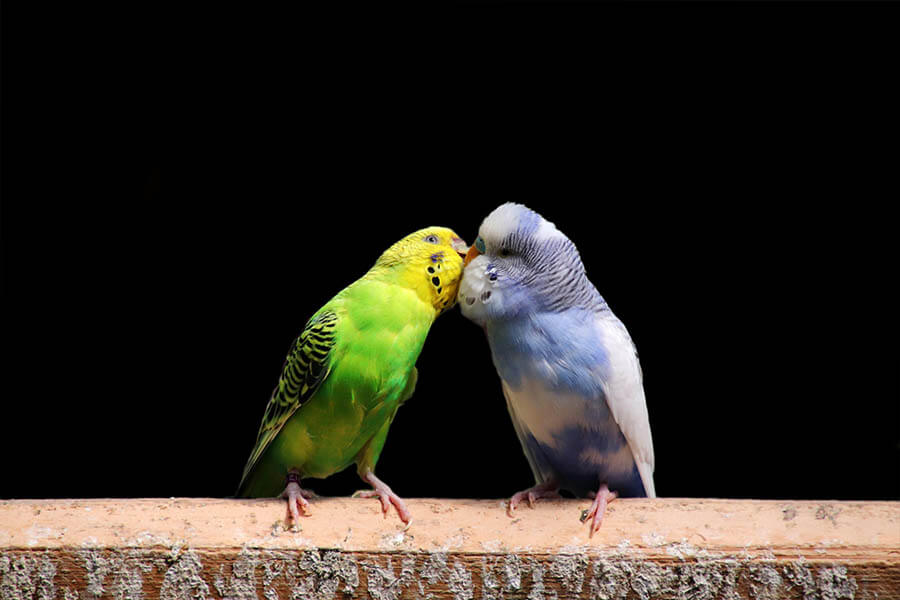| Java Finches Intro | Appearance | Temperament | Speech & Vocalization |
Courtship Behavior | Diet | Health Issues | Cage Requirements | Toys |
Java Finches – A Brief Intro
Java Finches, also known as Java Sparrows or Java Rice Finch, are small-sized, vibrant-colored, cheerful chirping birds that are native to the tropical islands of Indonesia-specifically Java, Bali, and Bawean. Besides these islands, these melodious birds are also common in Sri Lanka, Puerto Rico, Hawaii, and Jamaica. They are commonly found in grasslands, rice fields, and open areas with scattered trees. These birds have a strong preference for a warm and tropical climate. With their amiable personality and easy-to-care-for nature, Java Finches have gained popularity as pets all over the world.
In this article, we’ll explore all aspects of Java Finch’s temperament, their dietary and cage requirements to their social tendencies. So, if you’re a veteran bird enthusiast or a beginner, this article will be worthwhile to discover about these delightful little birds.
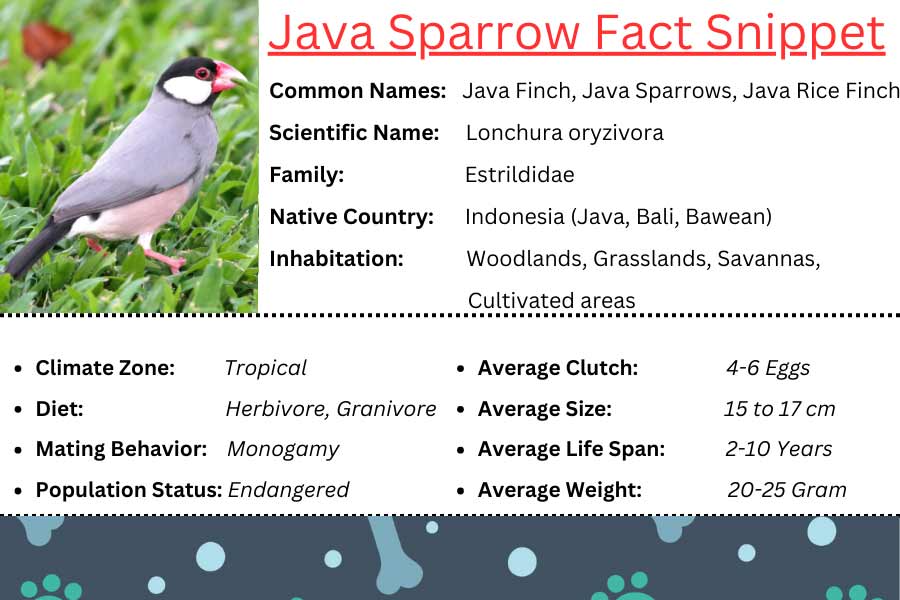
Appearance
The beauty of Java Finches is extremely appealing. With their vibrant plumage, ranging from shades of silver, red, orange, and yellow to black and white, these birds are a feast for the eyes. Their intricate patterns and unique color combinations make them a stunning addition to any aviary or bird collection.
Java Finches belong to the Estrildidae finch family tree. With an average size of about 5.9 to 6.7 inches and an average weight of 25 grams, these birds have distinct features giving them a hardy look.
They have firm light pinkish-white beaks, rounded eyes encircled with pink to red, and comparatively fragile pink legs. Their heads are black, cheeks are white that are outlined with thin black lines. With a silky bluish-grey fluffy chest and mantle, these colorful birds perfect their beauty. They have short black-feathered tails that harmonize the picture-perfect coloring and marking of the Java Finches.
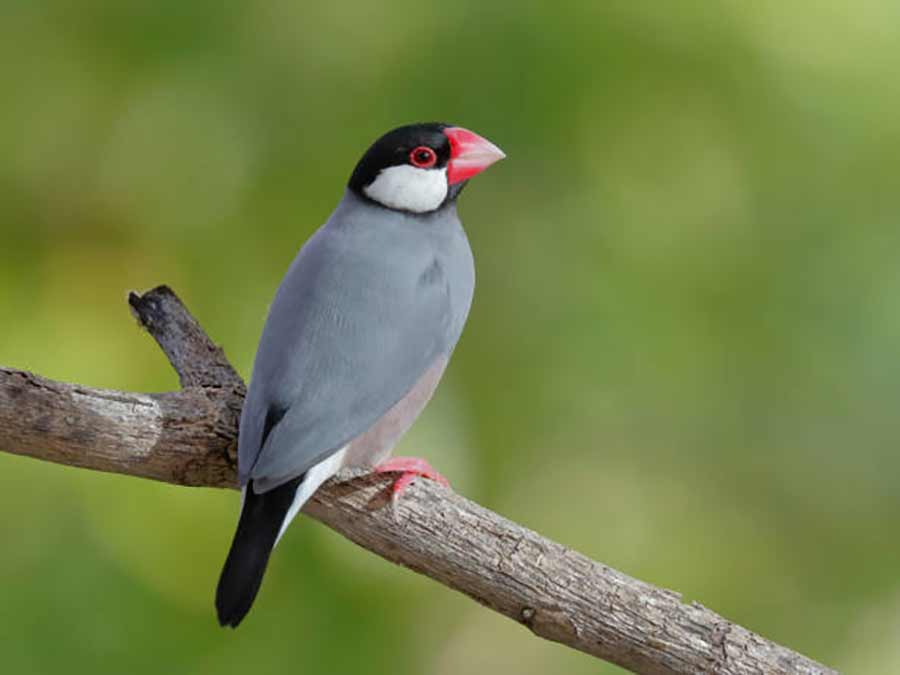
Temperament
Java Finches are non-aggressive social birds that, in the wild or captivity, love to be in flocks with their kind. However, they are quite friendly with other finch species and don’t get much bothered by their presence. In fact, their temperament is all about the environment in which they live or are raised. Some bird enthusiasts successfully form strong bonds with these birds but not all are lucky in this context. Although they are social birds, they are also timid to human interaction.
Due to their live, active, and playful nature, Java Finches enjoy exploring their surroundings and engaging in various activities such as bathing, preening, and playing with toys. Being highly adaptable, low-maintenance, and relatively easy to care for, Java Finches can thrive in different environments. This makes them an ideal choice for both experienced bird owners and beginners alike.
Speech & Vocalization
Java Finches are highly vocalized and produce different sounds and calls. One can’t resist listening to their continuous and tuneful chip-chip song. Going perch to perch, these restless birds don’t stop singing which creates a soothing effect in an aviary or a home. In addition, their sounds and vocalization change depending on different situations.
Besides their signature chip-chip song, when in danger, they produce high-pitched insistent alarming sounds/calls to alert other members. Before and during mating, a male Java finch makes a drum-like sound by clicking his bill with slow rattle notes that increase in pitch and speed and end harmoniously in a comparatively low tune. To learn more about the speech and vocalization of Java Finches, consult this article:
https://www.sciencedirect.com/science/article/abs/pii/S0376635718300901
Courtship Behavior of Java Finches
Java Finches have unique courtship behavior. They are monogamous and remain loyal to their partner.
The male Java Finch is a true romantic. During the breeding season, he will court the female with his enchanting singing and elaborate courtship displays. He slightly starts flapping his wings and expanding his tail with a pleasant chip-chip song. His beautiful melodies fill the air as he fluffs his feathers and hops around the female, showing off his vibrant plumage.
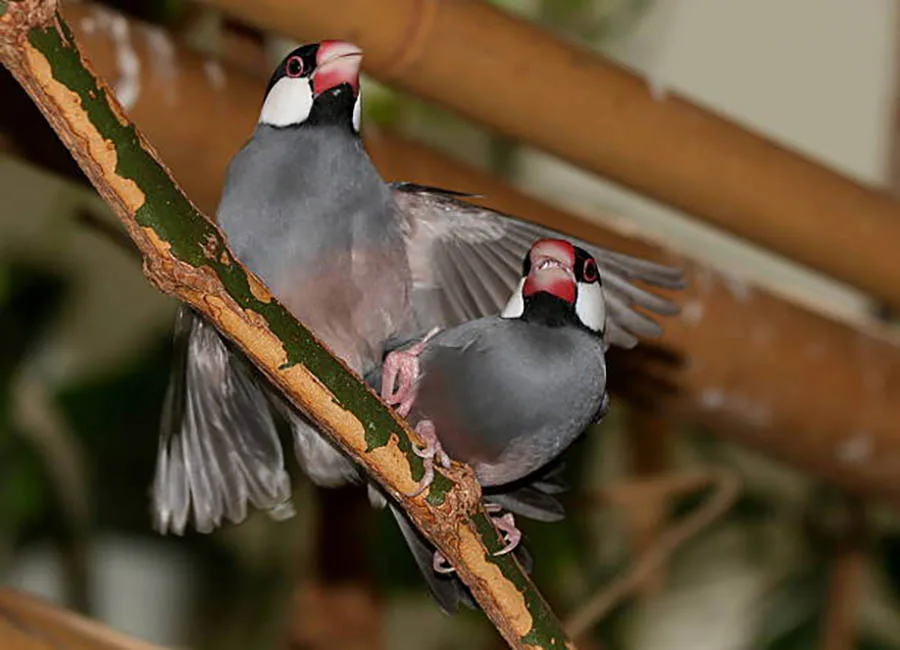
Occasionally, the male Java finch may offer food before sex. The females carefully observe these displays and become submissive for mating. This courtship ritual is not only a display of affection but also a way for the male to demonstrate his fitness and suitability as a mate.
What Do Java Finches Eat?
Though famous for eating Rice in the wild, Java Finches are primarily Herbivorous/ Granivorous. However, in captivity, to ensure the optimal health of these cute birds, a well-balanced, nutritious but varied diet is essential.
Java Finches love to eat a variety of seeds, fresh fruits, and vegetables. Seeds such as White French Millet, Canary seed, Yellow and Red Panicum, Japanese Millet, and hemp are excellent choices because they closely are similar to the birds’ natural food sources. Moreover, incorporating bird-safe fresh fruits such as apples, melons, and berries and bird-loving leafy green vegetables like spinach and kale into their diet provides essential vitamins and minerals.
Occasionally, offering well-crushed eggs or oysters and shells is good for providing Java Finches with the required protein and calcium.
Common Health Issues in Java Finches
While Java Finches are generally hardy birds, they can occasionally encounter health issues. Common health problems include:
Respiratory infections such as Aspergillosis – a fungal disease
Avian Polyomavirus Infection (APV) – a highly threatful viral disease
Avian Gastric Yeast (AGY) – a bacterial infection
Avian Pox – a rapidly spreading deadly infection
Besides these health issues, Java Finches are also highly vulnerable to developing mite infestation, and internal parasites. However, maintaining a clean and hygienic environment, regular vet check-ups, a well-balanced and nutritious diet, and proper care can help prevent these health issues in Java sparrows.
In addition, many avian experts recommend a deliberate quarantine of 7 days for new birds before introducing them into the cage. They also suggest separating affected birds for at least 3 to 4 weeks to prevent any spread of bacterial, or viral infections.
Moreover, proper hygiene is necessary for the health of these birds. Regularly cleaning the cage, perches, and toys helps prevent the buildup of bacteria and parasites. We also recommend using bird-safe cleaning products and avoiding strong chemicals that may be harmful to the birds.
Cage Requirements of Java Finches
A comfortable and spacious cage that doesn’t restrict their flights is the primary requirement of keeping Java Finches thriving. Though the cage dimensions depend on the quantity of birds, for 2 to 4 birds the ideal dimensions of a cage are 30 inches in length, 20 inches in width, and 20 inches in height.
The cage should be made of solid materials and have horizontal perches that allow the finches to climb and exercise. Providing a variety of perches with different textures, such as wooden branches or natural grass perches, helps maintain their foot health and prevents any discomfort while perching. These perches can mimic the branches and twigs found in their natural habitat, giving them a sense of familiarity.
Unless you intend to breed Java Finches, avoid providing nesting boxes in the cage. They are prolific breeders and would multiply rapidly in case you give them nesting material and boxes.
Toys for Java Finches
Providing bird-safe playing stuff like small toys, jingling bells, and swings is a good idea to keep Java Finches happy and engaged. When selecting toys for these birds, it’s important to choose ones that are safe and stimulating. Toys that encourage foraging behavior, such as puzzle feeders or treat-dispensing toys, can provide great mental stimulation and prevent boredom.
Let’s Wrap it Up!
Java Finches, with their vibrant colors, melodious songs, and social nature, provide endless joy to all bird lovers around the world. Understanding the behavior, health issues, and caging requirements of these birds is the prerequisite for keeping them happy. By creating a suitable environment, offering a balanced diet, and providing them with the right company, you can create a happy and healthy home for your Java Finches. Don’t forget to embrace the unique qualities of each bird, appreciate their beauty, and cherish the moments spent with them.
Jehanzaib Ahmed
CEO
Meet Jehanzaib Ahmed, the Paw-some Force Behind Wildlypet!
As a lifelong animal lover, he has turned his passion into a profession. With an unwavering love for all creatures, he founded WildlyPet to provide top-notch care for your pet friends. With good experience in the pet care industry, he is a seasoned expert in ensuring the health and happiness of pets. His knowledge extends from pet nutrition to behavioral training, making him your go-to guru for all things pet-related.
Beyond his business, he is deeply involved in the local pet-loving community. He actively supports rescue organizations and advocates for pet adoption, believing that every pet deserves a loving home.


